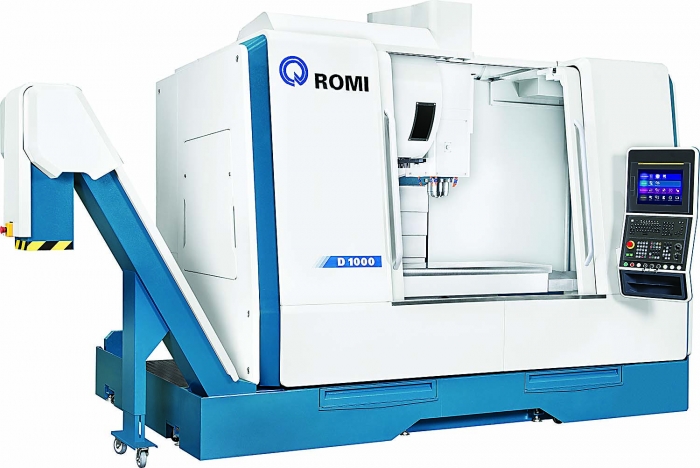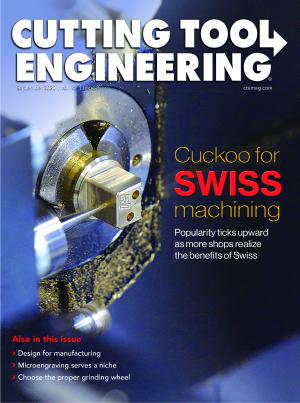You may have seen machine tools with the same names before. But you’ve never seen anything like the new generation D series vertical machining centers from Romi Machine Tools Ltd. in Erlanger, Kentucky, said Regional Sales Manager Steve Reeves.
He said although the latest D series machines kept the names of their predecessors, “they are brand-new machines from top to bottom.”
In the U.S., Romi Machine Tools sells three D series models: the 6,577 kg (14,500 lbs.) D 800, which offers 787 mm (31") of x-axis travel; the 6,895 kg (15,200 lbs.) D 1000, which offers 1,016 mm (40") of x-axis travel; and the 6,985 kg (15,400 lbs.) D 1250, which offers 1,270 mm (50") of x-axis travel. Maximum travel for all three models is 610 mm (24") along the y-axis and 635 mm (25") on the z-axis.

The D series VMCs have been redesigned completely for improved performance. Image courtesy of Romi Machine Tools
In most cases, Reeves said, the fact that the D 800 provides as much y- and z-axis travel as its larger counterparts is an advantage because customers usually want more travel distance along those axes. On the other hand, this also makes the D 800 a larger machine.
“If you need to get a machine into a very tight space,” he said, the D 800 “may not physically fit while some of our competitors’ smaller machines will.”
Like all Romi machine tools, D series machines feature Romi-made cast-iron beds that absorb vibration. In addition, all the machines are equipped with big-bore, 40-taper, direct-drive spindles. The company points out that direct-drive technology offers low maintenance and improved accuracy and repeatability, plus the big-bore 40-taper boosts stiffness and allows increased depth of cut during machining.
Compared with the previous D series versions, the new machines show cutting depth increases of up to 133% before vibration occurs, according to testing by Romi. In machining operations, Reeves said, the result is fewer passes and shorter cycle times.
D series spindles operate at speeds of 10,000 or 15,000 rpm, which he said is too low for minting and other applications that require very high spindle speeds. He noted, however, that the addition of a speeder head could boost the speed of D series spindles to 60,000 rpm.
Reeves said the new machines are the first in North America equipped with the Fanuc 0i-MF iHMI CNC, which includes a 381 mm (15") touch screen and a high-speed, high-quality package. The latter, he said, presents a variety of machining speed and surface finish options in a grid-style arrangement of boxes on the screen for operators. This makes it easy to determine the proper trade-off between cycle time and surface finish for a particular application.
“The vertical column is speed,” he explained, “and the horizontal column is surface finish. As you (increase) speed, generally you will sacrifice surface finish. So this allows users to exactly choose their priorities. For example, you don’t need the utmost accuracy when roughing, so you can (opt for more) speed for roughing cycles.”
Other key features of the new machines include sensor-based thermal compensation, linear roller guides that facilitate feed rates up to 40 m (1,575") per minute and a 30-tool automatic vertical toolchanger.
Still, Reeves said the machines aren’t unique in the sense that they provide many things that competitor machines lack.
Instead, “we’re unique because we offer extremely well-equipped machines at a much better price,” he said, adding that shops might have to spend 50% more to get other machines with the same features as these new offerings.
Reeves said part of the dramatic price difference stems from Romi Machine Tools owning a 139,355 m² (1.5 million sq. ft.) facility in Brazil, where the company pours its own castings and does a lot of other manufacturing work that competitors outsource.
“They buy components and assemble machines,” he said. “We actually build machines.”
Contact Details
Related Glossary Terms
- centers
centers
Cone-shaped pins that support a workpiece by one or two ends during machining. The centers fit into holes drilled in the workpiece ends. Centers that turn with the workpiece are called “live” centers; those that do not are called “dead” centers.
- computer numerical control ( CNC)
computer numerical control ( CNC)
Microprocessor-based controller dedicated to a machine tool that permits the creation or modification of parts. Programmed numerical control activates the machine’s servos and spindle drives and controls the various machining operations. See DNC, direct numerical control; NC, numerical control.
- depth of cut
depth of cut
Distance between the bottom of the cut and the uncut surface of the workpiece, measured in a direction at right angles to the machined surface of the workpiece.
- feed
feed
Rate of change of position of the tool as a whole, relative to the workpiece while cutting.
- stiffness
stiffness
1. Ability of a material or part to resist elastic deflection. 2. The rate of stress with respect to strain; the greater the stress required to produce a given strain, the stiffer the material is said to be. See dynamic stiffness; static stiffness.
- toolchanger
toolchanger
Carriage or drum attached to a machining center that holds tools until needed; when a tool is needed, the toolchanger inserts the tool into the machine spindle. See automatic toolchanger.


